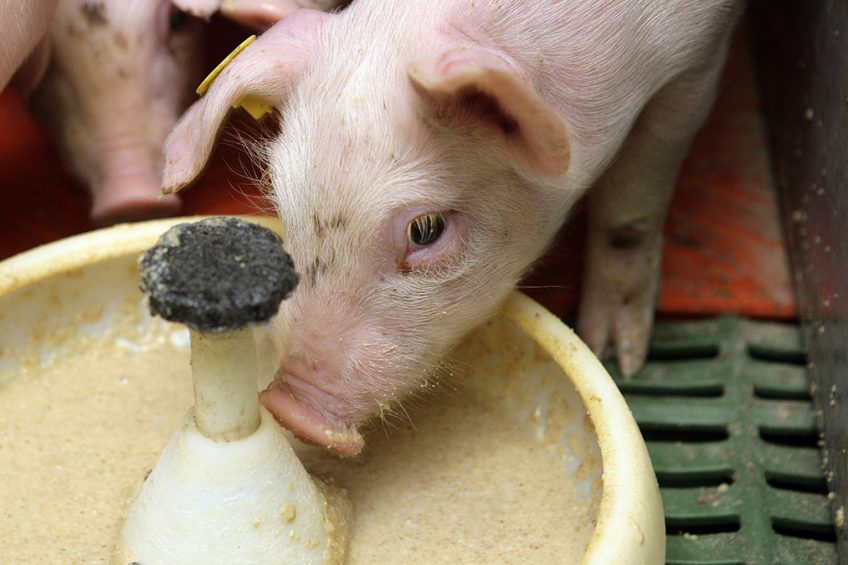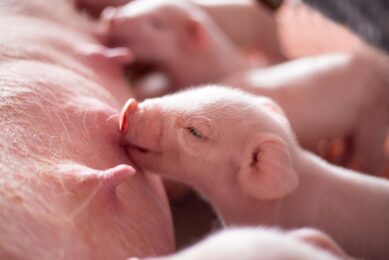The importance of a transition weaning diet

Recent research indicates that piglets will thrive with a proper transition diet prior to weaning, to allow them to prepare for a grain-based diet after weaning. What should be the goals when formulating a good transition diet? Dr Francesc Molist of Schothorst Feed Research discusses the options.
The various stressors piglets are exposed to at weaning in combination with the impaired gut and immune function make newly weaned piglets extremely vulnerable to post-weaning diseases. In the past, nutritionists could mask these gastro-intestinal diseases with pharmaceutical levels of zinc and copper. In Europe however, copper and zinc restrictions in piglet diets are or will be in place.
Low feed intake during the immediate post-weaning period is one of the stressors piglets are exposed to at weaning, with all kinds of consequences for gut function and health. One way to reduce the (short-term) loss in feed intake is by habituating piglets to solid feed prior to weaning. In that respect, a transition diet may be advised that connects the pre- and post-weaning period more closely.
Creep feed, weaner diet or sow diet
For instance, in 2018, a team around Pil Seung Heo, Seoul National University, South Korea, performed a trial in which piglets were either given creep feed, a weaner diet, or a sow diet pre-weaning. Post-weaning, they all received the weaner diet that some litters already received pre-weaning. The results of this trial showed that litters that were fed creep feed pre-weaning had the highest total feed intake pre-weaning, though with a similar number of eaters, compared with the other two treatments.
In the first 2 weeks post-weaning however, piglets that were fed the weaner diet pre- and post-weaning had a higher post-weaning feed intake than the other 2 groups, and a higher post-weaning body weight gain than the creep feed group. Interestingly, the sow diet group had an intermediate body weight gain in the 1st 2 weeks post-weaning, and an improved feed efficiency between week 2 and 5 post-weaning compared with the other 2 dietary treatment groups.
Together, these results may suggest that the similarity between the pre- and post-weaning diet composition is more important for post-weaning performance, than the absolute intake level of solid feed pre-weaning.
Pre-weaning solid feed intake
This is supported by the results of a paper published by a team around Anouschka Middelkoop, Wageningen University & Research in the Netherlands in 2019. In this research, 2 dietary treatment groups differed substantially in pre-weaning solid feed intake, but this difference in feed intake did not sustain post-weaning, when a different diet as compared to pre-weaning was fed (with a similar post-weaning diet across all treatment groups).
It is therefore considered important to provide the same diet (at least the last week/days) pre-weaning and during the initial post-weaning period, for piglets to recognise the post-weaning diet behaviourally (reduce food neophobia), but also physiologically (prepare the gut and gut microbiota).
What should transition diets focus on?
However, whether this transition diet should focus on achieving high energy intakes or supporting gut health and development remains a point of discussion. Towards weaning at 3-4 weeks of age, the milk production of the sow decreases the last week of lactation (around week 3), while piglets increase the consumption of solid feed.
In current pig farming conditions, feed intake pre-weaning is highly variable between litters and can be around 250-300 g per piglet that are weaned at 4 weeks of age.
Pre-weaning feed consumption per piglet
The strategy would be to reach a pre-weaning feed consumption of around 400-450 g per piglet (with a weaning age of 4 weeks) in order to ensure that when piglets are weaned, they are familiar with the solid feed and have a higher post-weaning feed intake. Milk is generally supplying mainly energy (lactose and fat) and is poor in protein and amino acids. To mimic sow milk, creep feed is often nutrient dense and formulated with expensive ingredients such as milk by-products and highly digestible ingredients such as plasma protein to help piglets with the nutrient uptake.
Nevertheless, with current weaning ages, creep feeding may only limitedly improve pre-weaning piglet growth or may only result in a reduced body weight variation within litter.

Pig Progress experts talk
To read more Pig Progress expert opinions
Adjusting to grain-based feed after weaning
Besides, when piglets are fed highly digestible creep feed, it is not clear whether they can adjust to the grain-based feed after weaning without gastro-intestinal disturbance. In addition, it could be speculated that the nutrient density of the pre-weaning diet should not be too dense, as a nutrient-dense diet is likely to result in gastrointestinal problems or can lead to a prolonged feeling of satiety as seen in weaned piglets.
In that respect, the transition diet should be formulated to complement sow milk intake and stimulate gut development rather than mimicking its composition to achieve high energy intakes.













